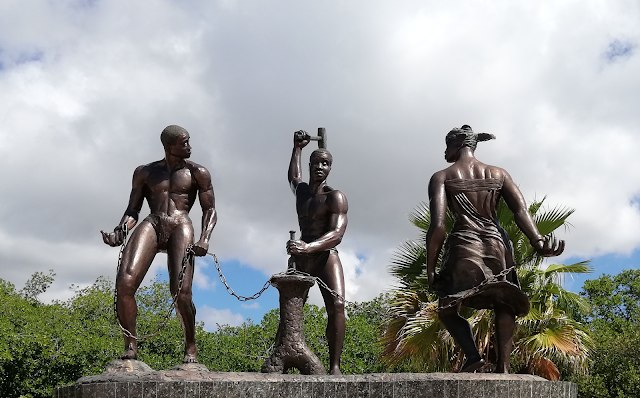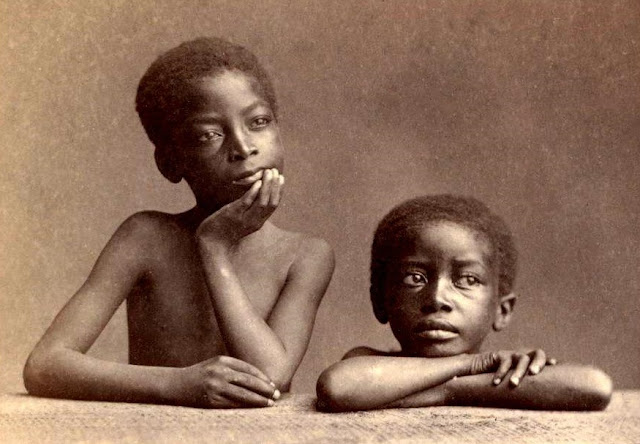The Other Black Revolutions
The Haitian Revolution is known for its great success at establishing a civil and independent society of individuals with the potential to determine their own destiny. It was a revolution against all odds. What started as a small camp of rebels became something beyond the wildest imaginations. Not only did the people of Haiti manage to exceed their own expectations, but they also disproved popular prejudices of that period regarding the capabilities of African people.
Still, questions remain.
Was the Haitian Revolution an anomaly?
Were there other revolutions like it?
Let's start with this question:
Was the Haitian Revolution the only revolution led by enslaved people in modern history?
The answer is no.
The Haitian Revolution was the only one that culminated in the formation of an independent nation-state. But there were others.
We can sort slave revolts into four different categories based on the motives of the leaders.
There were the revolutionary revolts, the reformatory revolts, the retaliatory revolts, and the redemptive revolts.
Revolutionary plans were those which sought to topple existing social and political structures and to replace them with new social and political structures.
The 1795 rebellion of José Leonardo Chirino (1754-1796) in Venezuela is an example of a revolution because it sought to establish a new nation. The Curaçaoan journalist Eugène Godfried (1952-2009) identified four of the declared objectives of Chirino's rebellion:
- Application of the “French law,” meaning the establishment of a democratic republic;
- Freedom of the enslaved Africans and abolition of slavery [something even Simon Bolivar was not ambitious enough to accomplish for Venezuela in his lifetime];
- Suppression of the duties paid for the indigenous people (delay) and the taxes such as “alcabala”;
- Elimination of the White aristocracy.
Chirino and his associated did not live to see the fulfillment of these plans.
A revolt doesn't need a written or verbally expressed declaration of rights and grievances in order to be considered a revolution. The very act of Charles Deslondes' rebels donning military uniforms before they commenced upon their destruction of Louisiana plantations in 1811 was a political statement. It may very well be considered an announcement of their intent to fight for a nation of their own.
They were not alone in these endeavors. There is a great saying, after all: great minds think alike. Charles Deslondes was gunning for New Orleans just as Gabriel Prosser wanted to take Richmond and Denmark Vesey had his sights on Charleston. What else did they have in common? None of these prophets would reach their promised lands.
Harvard historian Vincent Brown, who wrote the book
Tacky’s Revolt: The Story of an Atlantic Slave War (2020), views Tacky's War of 1760 and 1761, in Jamaica, as a revolution with the intent to "win the colony from the British" as the North American colonists would do and as the Haitians would also do in their war against the French.
Brown argues that the Coromantee, a conglomerate of people who had been taken from West Africa, were merely continuing and refining their original warrior cultures in the New World. He refers to Tacky' War as "an extension of wars on the African continent," some of which had been motivated by the expansion of communities actively engaged in slave trading.
The extent and effectiveness of secret communication networks between enslaved Blacks as an integral tool for rallying people to the cause of freedom has led some scholars to believe that rebel slaves had grand ambitions of building an empire in places like the Caribbean and - as Harvard's
Daniel Rasmussen claims of Deslondes' rebellion - along the southern coast of the United States. This, they presume, was destined to be both the primary and the ultimate goal of rebellion.
If the controversial king of Antebellum American history
Eugene Genovese (1930-2012) is to be believed, even Nat Turner was not free from these delusions of grandeur. In his book
From Rebellion to Revolution (1992), Genovese imagined Minister Turner stopping to construct "a large Maroon colony in the [Great] Dismal Swamp" some time after his conquest of Southampton County.
In light of the rebels' shortcomings, it is easy to believe that framing their revolts as revolutions (and in hindsight, notwithstanding*) offers those hapless renegades some 21st century poetic justice. I believe that in actuality, insisting upon a strictly revolutionary view of slave rebellions may be doing us more harm in our appraisal of the Black struggle than good.
Were rebel slaves not trying hard enough if their plan did not immediately call for the violent overthrow of a tyrannical government? Are we to believe that those who went to tryouts but didn't make the cut were the "unlucky" ones and it is simply because they were not playing the "game" the same way the Haitians did?
It must be understood that a revolt evolves based on changing prospects and participants, and furthermore, not every revolt develops into a revolution. The absence of any social accountability on the part of the establishment following mass rebel suicides such as the Ibo Landing off the Georgia coast in 1803 and those that took place during the recapture of St. Jan island from Breffu and her rebels in 1733 are evidences that societal changes were neither the expectation nor the goal in at least those cases of rebellion.
I must reiterate my belief that the word rebellion is not synonymous with the word revolution.
There are cases in which revolution was not the option that rebels chose and that is okay. Given the circumstances they were faced with, we must give them credit for how they did claim victories in other ways.
Reformatory plans were those which sought to introduce new policies or replace existing policies in the framework of the government or society.
 |
One of the Tula monuments, commemorating
the uprising against slavery led by Tula.
This monument stands at the edge of
the salt pans near Jan Kok Mansion
Jan Kock, Curaçao
October 13, 2016
Photo by Flickr User -JvL- |
The 1795 rebellion led by Tula Rigaud in Curaçao was a reformatory one.
Tula and his followers first marched to the residence of their former owner and disputed his right to hold them as slaves (they actually declared they were no longer his slaves). When they did not receive a satisfactory answer, they continued on a rampage through the island.
A priest was sent to negotiate terms with Tula. Tula agreed to meet with the priest who was announced the government's proposals to Tula. He must have expected that Tula might outline some terms in his personal favor that he would agree to if the Dutch colonial wanted him to turn himself in. But Tula's
demand was for the same freedom that the people of Haiti had claimed for themselves as one community. Tula was not going anywhere. But, while he considered Curaçao his home, he was not concerned about taxes or citizenship. What he did want was for the Curaçao he knew and loved to be a free and just society.
We must be free here.
Retaliatory plans were those which were focused primarily on taking lives or damaging property.
As long as it lasted, the 1831 insurrection of Nat Turner in Virginia did not seek to replace the powers that be, but to destroy them. There was no preliminary constitution. No long-term plans for a new nation. There was only a rhetorical ultimatum: freedom or death. This is the most popular example of a retaliatory revolt.
Redemptive plans were those which were aimed primarily at rescue or escape.
Almost all of the mutinies which happened on slave ships were redemptive plans of rebellion. Often times, the pilot or other crew members were spared for the purpose of returning the rebels to Africa. These rescue efforts were not only for the participants of the rebellion but for any Africans who remained on board.
There were also redemptive rebellions on land. The planned revolt of Denmark Vesey in South Carolina was going to be a redemption. While on trial, Vesey's disciples attested that after freeing enslaved Africans on plantations around Charleston, his ultimate goal was for them to sail to freedom in Haiti.
Finally, redemption applies in the case of rebellions in which the rebels chose to take their own lives rather than to continue another moment under the subjugation of others. Instead of rescuing others, they were sparing themselves.
Now, we come to our second question:
Apart from the Haitian Revolution, what was the largest revolt led by enslaved African people in the Americas?
There were a few known mass uprisings of enslaved people in the Americas that were on a similar scale to the revolution in Haiti.
In my research, one stands out the most.
That would be the Baptist War (also commonly referred to as the Sam Sharpe Rebellion), which happened on the island of Jamaica during the years of 1831 and 1832. What is most surprising about the Baptist War is how well it had been organized and executed.
Based on reports from that time, more than 60,000 rebels were involved. This was an entire fifth of the total population of enslaved people in Jamaica. In other words, one out of every five slaves was down for the struggle. Even more remarkable is the fact that this revolt was actually a non-violent demonstration. Sam Sharpe made it clear to his disciples from the very beginning that this was to be a strike for wages. So although it was within their power to attempt an overthrow of the colonial government and to establish a settlement of their own, this "war" was virtually bloodless. Only a handful of planters lost their lives.
The rebels thought that their masters would be moved by their protests. Maybe they would have a change of heart and, eventually, they would come to respect their former stepladders as equals. Needless to say, the rebels of the Sam Sharpe Rebellion were massacred in droves. This, perhaps, is why we don't hear about Deacon Sam Sharpe's Rebellion in Jamaica as much as we hear about General Toussaint's revolution in Haiti, which had already laid the foundations of a new nation thirty years prior.
But the Baptist War was by no means a failure. It was quite the opposite. The Black people of Jamaica had shown to the establishment a fraction of the damage that they were capable of. And for both sides of the struggle, enough was enough. This crusade for Black liberation added to mounting pressures against pro-slavery factions in mainland Britain. Public fears of further disturbances in the colonies had suddenly reached a boiling point. The following year, the British parliament enacted the Slave Emancipation Act (or Slavery Abolition Act), outlawing the practice of slavery altogether.
It is for this reason that Harvard historian Tom Zoellner, who wrote the book Island on Fire: The Revolt That Ended Slavery in the British Empire (2020), refers to the Baptist War as "a politically successful revolution." The Baptist War did not just end slavery in Jamaica. It opened the floodgates for the freedom of enslaved men, women, and children all around the world.
- Omri C.








Comments
Post a Comment